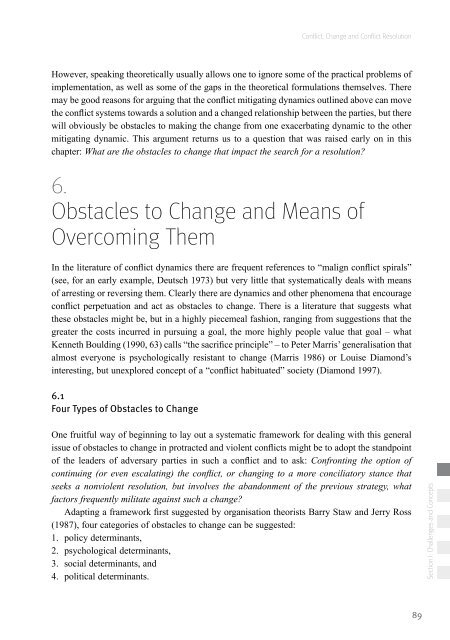Conflict, Change and Conflict Resolution - Berghof Handbook for ...
Conflict, Change and Conflict Resolution - Berghof Handbook for ...
Conflict, Change and Conflict Resolution - Berghof Handbook for ...
You also want an ePaper? Increase the reach of your titles
YUMPU automatically turns print PDFs into web optimized ePapers that Google loves.
<strong>Conflict</strong>, <strong>Change</strong> <strong>and</strong> <strong>Conflict</strong> <strong>Resolution</strong><br />
However, speaking theoretically usually allows one to ignore some of the practical problems of<br />
implementation, as well as some of the gaps in the theoretical <strong>for</strong>mulations themselves. There<br />
may be good reasons <strong>for</strong> arguing that the conflict mitigating dynamics outlined above can move<br />
the conflict systems towards a solution <strong>and</strong> a changed relationship between the parties, but there<br />
will obviously be obstacles to making the change from one exacerbating dynamic to the other<br />
mitigating dynamic. This argument returns us to a question that was raised early on in this<br />
chapter: What are the obstacles to change that impact the search <strong>for</strong> a resolution?<br />
6.<br />
Obstacles to <strong>Change</strong> <strong>and</strong> Means of<br />
Overcoming Them<br />
In the literature of conflict dynamics there are frequent references to “malign conflict spirals”<br />
(see, <strong>for</strong> an early example, Deutsch 1973) but very little that systematically deals with means<br />
of arresting or reversing them. Clearly there are dynamics <strong>and</strong> other phenomena that encourage<br />
conflict perpetuation <strong>and</strong> act as obstacles to change. There is a literature that suggests what<br />
these obstacles might be, but in a highly piecemeal fashion, ranging from suggestions that the<br />
greater the costs incurred in pursuing a goal, the more highly people value that goal – what<br />
Kenneth Boulding (1990, 63) calls “the sacrifice principle” – to Peter Marris’ generalisation that<br />
almost everyone is psychologically resistant to change (Marris 1986) or Louise Diamond’s<br />
interesting, but unexplored concept of a “conflict habituated” society (Diamond 1997).<br />
6.1<br />
Four Types of Obstacles to <strong>Change</strong><br />
One fruitful way of beginning to lay out a systematic framework <strong>for</strong> dealing with this general<br />
issue of obstacles to change in protracted <strong>and</strong> violent conflicts might be to adopt the st<strong>and</strong>point<br />
of the leaders of adversary parties in such a conflict <strong>and</strong> to ask: Confronting the option of<br />
continuing (or even escalating) the conflict, or changing to a more conciliatory stance that<br />
seeks a nonviolent resolution, but involves the ab<strong>and</strong>onment of the previous strategy, what<br />
factors frequently militate against such a change?<br />
Adapting a framework first suggested by organisation theorists Barry Staw <strong>and</strong> Jerry Ross<br />
(1987), four categories of obstacles to change can be suggested:<br />
1. policy determinants,<br />
2. psychological determinants,<br />
3. social determinants, <strong>and</strong><br />
4. political determinants.<br />
89<br />
Section I: Challenges <strong>and</strong> Concepts
















